Moment's Notice
Reviews of Recent Recordings
(continued)
Paul Rutherford
In Backwards Times
Emanem CD 5045
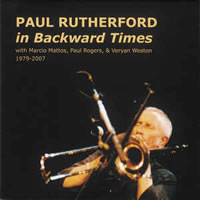 By a quick count, Paul Rutherford is the most documented musician on the venerable Emanem label. The trombonist appears on over 30 releases spanning from his participation in the 1966 Spontaneous Music Ensemble session “Challenge” to sessions just before his untimely death. But Martin Davidson’s dedication continues to pay off as evidenced by this new compilation, gathering together previously unissued solos, along with a duo and a trio recorded just three months before he died. One might wonder whether these new recordings would offer up anything revelatory, but Davidson always manages to astound with his curatorial prowess, and this one is no exception.
By a quick count, Paul Rutherford is the most documented musician on the venerable Emanem label. The trombonist appears on over 30 releases spanning from his participation in the 1966 Spontaneous Music Ensemble session “Challenge” to sessions just before his untimely death. But Martin Davidson’s dedication continues to pay off as evidenced by this new compilation, gathering together previously unissued solos, along with a duo and a trio recorded just three months before he died. One might wonder whether these new recordings would offer up anything revelatory, but Davidson always manages to astound with his curatorial prowess, and this one is no exception.
Things start off with “Duet for One,” a solo for trombone and electronics recorded in November 1979. Rutherford’s control of his instrument and its underlying overtones and multiphonics augmented by use of vocal inflection and mutes was expansive as evidenced on classics like his solo “The Gentle Harm of the Bourgeoisie.” But for a short while in the late ‘70s, he experimented with the addition of electronics and a voice mic. On this 22-minute outing, Rutherford tag-teams trombone and electronics, letting things veer perilously close to mayhem, then reeling it all in at just the right moments. “Solo for One,” from 2004 showcases the trombonist on his own, and in the intervening years, his playing had become a bit sparer, placing fillips and flurries against an open ground. There is nothing in the least bit reductive in his strategies. Instead, there is more patience in the way he lets the arc of the solo unfold. He also makes particularly effective use of the juxtaposition of the extremes of register of the horn, leaping effortlessly from the lowest growls to the highest, clarion peals.
Bassist Paul Rogers was a frequent collaborator of Rutherford’s going back to the late ‘70s when they played together with John Stevens. “Duet for Two” was recorded in 1988, a few months before their Emanem release “Rogues.” The sonorities of acoustic bass and trombone complement each other well and the 25-minute improvisation abounds with fluid, fleet conversational interplay. The two are attuned listeners and know when to leave space for each other and when to jump in and goad things along.
The final cut, “Trio Finale,” with Rutherford, Veryan Weston, and Marcio Mattos, provides a poignant conclusion. The trombonist had been working with Mattos as a duo and he convened the trio with Weston for a performance at the 2007 Freedom of the City Festival. This ended up being the last time Rutherford played in public; he died three months later. The short improvisation bristles and bucks along as the three ping pong ideas off each other with sprightly vigor. The three eschew any clear arc, instead gravitating toward sections of density and then backing off to let open sections emerge. It is a tribute to their mastery and experience how quickly they establish a sense of ensemble, balancing conversational interplay with collective voicings. Mattos’ use of electronics along with cello adds a particularly noteworthy touch. It’s hard to imagine more recordings of Rutherford’s left in the vaults. But if this release is any indication, let’s hope that Davidson brings it on!
—Michael Rosenstein
Irene Schweizer-Joey Barron
Live!
Intakt 293
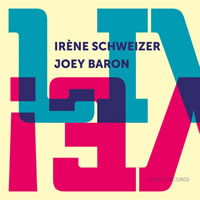 Pianist Irene Schweizer continues her string of superior duets with drummers in this spirited meeting with Joey Baron. Their chemistry is immediate and deep. They can’t seem to resist chiming in when one of them plays something that pleases the other – and they delight each other constantly for nearly an hour. They are so eager to connect and they put so much life and commitment into every piano note and drum sound that the music fairly jumps with joy. Each of the album’s seven improvisations is distinctive, but all possess a giddy, barriers-down sense of freedom that allows them to go in any direction. “Free for All” moves in and out of atonal disquietude, out-of-tempo pensiveness, and rollicking gospel jazz. “Up the Ladder” begins with disjointed drum patterns and piano lines that zip and dart in different directions and ends up with a boogie-woogie. Schweizer plays inside the piano on “String Fever,” with twinkling lines that lurch this way and that like a tipsy harpsichord; Baron enshrouds everything in cymbal washes and pokes and prods with snare and tom-tom and bass drum. “Blues for Crelier” rolls along over a South African groove, while “The Open Window” is a tap-dancing waltz. Their vocabulary is utterly modern, but there’s something eternal about their grace and swing.
Pianist Irene Schweizer continues her string of superior duets with drummers in this spirited meeting with Joey Baron. Their chemistry is immediate and deep. They can’t seem to resist chiming in when one of them plays something that pleases the other – and they delight each other constantly for nearly an hour. They are so eager to connect and they put so much life and commitment into every piano note and drum sound that the music fairly jumps with joy. Each of the album’s seven improvisations is distinctive, but all possess a giddy, barriers-down sense of freedom that allows them to go in any direction. “Free for All” moves in and out of atonal disquietude, out-of-tempo pensiveness, and rollicking gospel jazz. “Up the Ladder” begins with disjointed drum patterns and piano lines that zip and dart in different directions and ends up with a boogie-woogie. Schweizer plays inside the piano on “String Fever,” with twinkling lines that lurch this way and that like a tipsy harpsichord; Baron enshrouds everything in cymbal washes and pokes and prods with snare and tom-tom and bass drum. “Blues for Crelier” rolls along over a South African groove, while “The Open Window” is a tap-dancing waltz. Their vocabulary is utterly modern, but there’s something eternal about their grace and swing.
–Ed Hazell
Wadada Leo Smith
Najwa
TUM 049
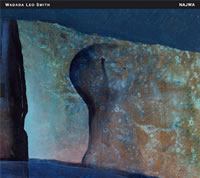 Usually it’s Cuneiform that releases Smith’s electric, fusion-influenced dates, but TUM’s long-standing support of the composer/trumpeter’s music makes them a natural outlet as well. At the heart of Najwa’s sound is a quartet of searing guitarists: Michael Gregory Jackson, Henry Kaiser, Brandon Ross, and Lamar Smith. Smith has worked with all of them abundantly, and they not only play nice together but each has a distinctive approach to the composer’s world. The rhythm core is, if anything, even more assertive. There’s Pheeroan akLaff on drums, Adam Rudolph on percussion, and bassist Bill Laswell is front and center, with his big, chorus-drenched shapes.
Usually it’s Cuneiform that releases Smith’s electric, fusion-influenced dates, but TUM’s long-standing support of the composer/trumpeter’s music makes them a natural outlet as well. At the heart of Najwa’s sound is a quartet of searing guitarists: Michael Gregory Jackson, Henry Kaiser, Brandon Ross, and Lamar Smith. Smith has worked with all of them abundantly, and they not only play nice together but each has a distinctive approach to the composer’s world. The rhythm core is, if anything, even more assertive. There’s Pheeroan akLaff on drums, Adam Rudolph on percussion, and bassist Bill Laswell is front and center, with his big, chorus-drenched shapes.
The record is a series of dedications, something that’s increasingly part of Smith’s composing. It starts off with the band in shape-shifting form on “Ornette Coleman’s Harmolodic Sonic Hierographic Forms: A Resonance Change in the Millennium.” It’s urgent, propulsive, and filled with electric energy. But what grabs me about this music is Wadada’s intense steadiness and focus on long tunes like these: he dishes out color, he punctuates, and delves into licks and runs sparingly. And through it all, he plays with a kind of unconscious sympathy with the guitarists, especially his longtime colleague Kaiser and with the unmistakable Ross.
On initial listen, some folks might wonder – when listening to the twin percussion blast, the Ayleresque melodies, or the deep blues that pop up here and there – about the function of the tunes’ dedicatees. But I think the point is not necessarily that the tunes possessed the sonic properties of their dedicatees’ music. Certainly “Ohnedaruth John Coltrane: The Master of Kosmic Music and His Spirituality in a Love Supreme” doesn’t sound altogether like Trane in its harmonic language, its chordal grounding, or the details of its articulation. But like the Ornette tune, it’s infused with a specific sense of liberation and a sonic density that may well be indebted.
The track for Ronald Shannon Jackson, subtitled “The Master of Symphonic Drumming and Multi-Sonic Rhythms, Inscriptions of a Rare Beauty,” gets as close as any track here to sounding like the dedicatee. It’s loaded with bustling, lateral cross-cuts and a nice tasty harmolodic theme with some distorted sizzle beneath. This kind of energy regularly crackles on Najwa, with lots of dirty grooves and stratospheric guitar invention. If you’re a fan of Smith’s electric music, there’s a lot to like. To my ears, Laswell takes up too much room on many of these performances. Anyone reading this likely already knows the degree of their tolerance for that sound. I will say that it didn’t ultimately compromise these tunes for me, even if there were some wincing moments.
But you could always just skip to the title track, a lustrous dark miniature, with Smith’s most urgent, intense playing of the date. Or check out the mournful, elegant “The Empress, Lady Day: In a Rainbow Garden, with Yellow-Gold Hot Springs, Surrounded by Exotic Plants and Flowers.” It’s lambent, filled with swells and delays, and Jackson’s acoustic sounds marvelous. In short, a fine record overall, one that testifies yet again to Smith’s belief in transportation to new imaginaries via sound.
–Jason Bivins
Wadada Leo Smith
Solo: Reflections and Meditations on Monk
TUM 053
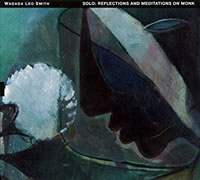 Solo albums from the composer/trumpeter Wadada Leo Smith are always a treat, but this program is a rare dip into non-Miles repertory. Just about everyone who listens to Smith marvels continually about the amount of space there is in his playing and writing, whatever the setting. At their best, Smith’s unaccompanied outings really spotlight these qualities.
Solo albums from the composer/trumpeter Wadada Leo Smith are always a treat, but this program is a rare dip into non-Miles repertory. Just about everyone who listens to Smith marvels continually about the amount of space there is in his playing and writing, whatever the setting. At their best, Smith’s unaccompanied outings really spotlight these qualities.
On this record, he brings his reflective, uncluttered style to the monastic repertoire in ways that, inevitably, invite comparison to Steve Lacy’s honed, loving performances. But from the opening notes, we’re reminded of Smith’s different approach, and of his language emphasizing sustain, harmonic modulation, and playful note-bending. His “Ruby, My Dear” is elegant, unhurried, and there’s a fascinating elegiac turn in the middle.
That’s a detail that exemplifies this recording’s strengths. Smith is able to fully immerse himself in the logic and lyricism of Monk’s tunes, but nonetheless layer in elements that are distinctly his own. There are regular harmonic curveballs, or long, languorous pauses in the phrasing, or compelling technical left turns abounding. And on a few pieces, those he composed himself, Smith does the inverse: he brings a distinctly Monk-like logic to his own musical thinking. Hear this on the searching “Monk and His Five Point Ring at the Five Spot Café,” where Smith spends considerable time exploring the outer reaches of upper-register intervallic work, pinwheeling down chromatically, and rising again via scales. It’s also all over the superbly refined, high keening lines on “Adagio: Monk, the Composer in Sepia – Second Vision.” And the gorgeous “Adagio: Monkishness – A Cinematic Vision of Monk Playing Solo Piano” shows how effectively these very different musical and instrumental logics can merge.
But there’s no denying that it’s the transformed Monk tunes themselves that compel the most. There’s a profound, almost architectural sense of accomplishment in Smith’s take on “Reflections.” Like many of the performances here, there’s a rich, deft use of chromaticism, subtle registral or harmonic shifts, and bright lines. I was knocked out by Smith’s use of dark hues on “Crepuscule with Nellie,” with all kinds of phraseological invention that somehow never loses sight of that familiar melody. And on the wonderfully metamorphosed “’Round Midnight,” Smith makes his way through the piece with a just so attention to pitch, sustain, and space. And if you think about it, those are the three traits where these two masters meet in one music.
–Jason Bivins
James “Blood” Ulmer with The Thing
Baby Talk
The Thing Records / Trost TTR006
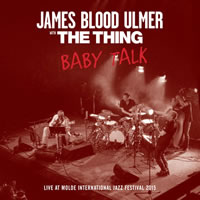 James “Blood” Ulmer’s string of recordings from the late ‘70s and early ‘80s provided an enthralling synthesis of the influences he absorbed from his playing with musicians like Ornette Coleman, Rashied Ali, and Frank Wright. Ornette’s stamp (and participation) was all over Tales from Captain Black, Ulmer’s debut as a leader. There were blues overtones that colored things as well showing up on outings like Are You Glad to Be in America? and his string of trio releases for Columbia. Ulmer also benefited greatly from alliances he formed with musicians like Arthur Blythe, David Murray, and Ronald Shannon Jackson, with whom he recorded some of the definitive recordings of the ‘80s. While his hard-scrabble, freely jaunting guitar sound is unmistakable, his recordings over the last decade have slowed to a trickle and missed the fire and spirit of his earlier work.
James “Blood” Ulmer’s string of recordings from the late ‘70s and early ‘80s provided an enthralling synthesis of the influences he absorbed from his playing with musicians like Ornette Coleman, Rashied Ali, and Frank Wright. Ornette’s stamp (and participation) was all over Tales from Captain Black, Ulmer’s debut as a leader. There were blues overtones that colored things as well showing up on outings like Are You Glad to Be in America? and his string of trio releases for Columbia. Ulmer also benefited greatly from alliances he formed with musicians like Arthur Blythe, David Murray, and Ronald Shannon Jackson, with whom he recorded some of the definitive recordings of the ‘80s. While his hard-scrabble, freely jaunting guitar sound is unmistakable, his recordings over the last decade have slowed to a trickle and missed the fire and spirit of his earlier work.
Thankfully, that all changes with this release, recorded live at the 2015 Molde International Jazz Festival along with the Scandinavian free-skronk trio, The Thing. This encounter with Mats Gustafsson, Ingebrigt Håker Flaten, and Paal Nilssen-Love is exactly the spark that Ulmer needed, placing himself alongside players who share the energy and potency of his earlier work. The compact, 35-minute set kicks in right away with “Interview,” a tune that appeared on Are You Glad to Be in America? The guitarist scrabbles out the theme as Håker Flaten and Nilssen-Love gradually amp up the momentum, setting things up for Gustafsson’s garrulous baritone fusillades, and the four hurtle their way with the guitarist’s thorny, angular punctuations setting the pace. “High Yellow,” a jagged bluesy abstraction benefits from Håker Flaten’s switch to electric bass, and the opening guitar/bass/drums trio section shudders along with a fidgety freedom. Gustafsson’s explosive tenor enters about a third of the way through and Ulmer gets a bit buried in the frenzied squall, but the quartet finds its footings in the final few minutes, concluding with the guitarist’s ringing jazz chords.
The title tune is from No Wave, Ulmer’s classic outing with the Music Revelation Ensemble along with Murray, Shannon Jackson, and Amin Ali, and the four totally nail it. (The Thing included this one on a 2001 recording with Joe McPhee so they’ve been digging in to the sing-song theme for a while now.) At 5 1/2 minutes, it is the shortest piece in the set, but they circle around the head and revel in collective interplay, volleying kernels of the melody back and forth with charged abandon over Nilssen-Love’s hurtling free shuffle. The closer, “Proof,” is the kind of proto-blues that Ulmer is so great at knocking out. It starts out with his dark, solo musings and keening modal lyricism which is matched effectively by Gustafsson’s plangent baritone and the brooding open pulse of their bandmates. The quartet syncs in, slowly building the intensity with supple, collective interplay, letting the momentum ebb and flow without losing the propulsive arc of the piece. This is the best recording of Ulmer’s in a while and one hopes that this is not the last meeting of these four.
—Michael Rosenstein
Trevor Watts Amalgam
Closer to You
Hi4Head Records HFHCD019
 Recorded in May, 1978, this reissue of Closer to You features saxophonist Trevor Watts, electric bassist Colin McKenzie, and drummer Liam Genockey in a set marked by a dynamic mix of free-wheeling raucous energy and a more somber, almost mournful atmosphere. Watts’ Amalgam gets out of the gate like a rocket ship on the opener, “De Dublin Thing.” His careening, wild alto saxophone is a vehicle of nearly unbridled spirit, and while his overblowing may not be for everybody, it does add to the urgency and immediacy of his playing. Genockey gets all over his kit, and McKenzie propels the trio while setting up his drummer for a number of hits and fills. “South of Nowhere” begins in a quieter mode that’s free of time, with Watts’ lamentations giving way to a groove. After a decrescendo that ends in near silence, McKenzie jumpstarts a whimsical march that sets the foundation for Watts’ playful Braxtonish excursions.
Recorded in May, 1978, this reissue of Closer to You features saxophonist Trevor Watts, electric bassist Colin McKenzie, and drummer Liam Genockey in a set marked by a dynamic mix of free-wheeling raucous energy and a more somber, almost mournful atmosphere. Watts’ Amalgam gets out of the gate like a rocket ship on the opener, “De Dublin Thing.” His careening, wild alto saxophone is a vehicle of nearly unbridled spirit, and while his overblowing may not be for everybody, it does add to the urgency and immediacy of his playing. Genockey gets all over his kit, and McKenzie propels the trio while setting up his drummer for a number of hits and fills. “South of Nowhere” begins in a quieter mode that’s free of time, with Watts’ lamentations giving way to a groove. After a decrescendo that ends in near silence, McKenzie jumpstarts a whimsical march that sets the foundation for Watts’ playful Braxtonish excursions.
The album’s centerpiece is the nearly twenty-minute “Dear Roland” – ostensibly for Roland Kirk, given his death a year earlier and Watts’ simultaneous playing of alto and soprano. As on “South of Nowhere” the trio begins in a soft, sparse, and darker mood which is occasionally interrupted and augmented by alto/soprano screeches, gongs, and tom rumbles. Watts plays a three note motive that McKenzie immediately echoes and transforms into the basis for a groove, which the trio explores for several minutes before fading and returning to the opening framework. The piece’s narrative arc and varied sonic textures make for an engaging conclusion to the original album.
This reissue also includes five previously unreleased bonus tracks. As before, Watts, McKenzie, and Genockey absolutely get after it. “Albert Like” has a weird, almost funky r&b feel over which Watts blows a series of catchy earworm hooks – that is until the cut abruptly ends, as if the tape ran out. The freely improvised “Bottle Alley” – which doesn’t quite have as much purpose as the other selections – has an audible tape hiss. And while the rocking, uptempo burner “Mad” scintillates, the intensity of the album’s original four tracks make what comes after almost too much. Bonus tracks or no, this new version of Closer to You – even in its quieter moments – hits fast and hits hard.
—Chris Robinson